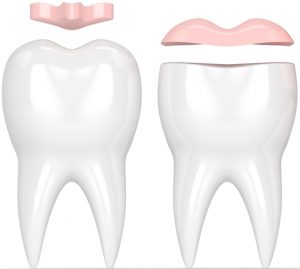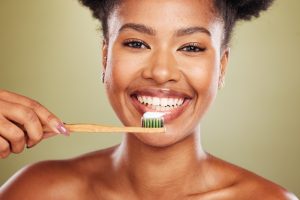Inlays and Onlays: Smile Restoration & Smile Preservation
You may have a tooth in need of better repair than a dental filling, but not need measures as drastic as a dental crown. In situations such as these, our San Luis Obispo dentists can provide inlays and onlays. These minimally invasive restorations can repair more extensive damage while preserving as much natural tooth enamel as possible. Learn more about inlays and onlays by dialing (805) 549-8483.
What Are Inlays and Onlays?
Inlays and onlays also called indirect fillings and partial crowns, are dental restorations used to repair damaged or decayed teeth. They are often employed when a traditional dental filling is insufficient, but a full dental crown is not necessary. These restorations are typically crafted from materials like porcelain, composite resin, or gold.
An inlay is a restoration that fits within the contours of the tooth, covering the area inside the cusps (raised points) of the tooth. It is used when the damage or decay is limited to the central part of the tooth and doesn’t extend to the cusps.
An onlay is a more extensive restoration that covers one or more cusps of the tooth.
It is employed when the damage or decay extends to the cusps but doesn’t require a full dental crown. Onlays are also known as partial crowns because they involve more surface coverage than inlays.
Benefits of Inlays and Onlays
Inlays and onlays offer a multitude of benefits both functional and aesthetic. Some of the many benefits of indirect fillings and partial crowns include:
- Conservative Tooth Structure Preservation: One of the primary benefits of inlays and onlays is they allow for the preservation of more a natural tooth structure compared to traditional crowns. Inlays and onlays require the removal of less enamel, as they are designed to fit within or cover only the damaged portion of the tooth.
- Custom Fit and Precision: Inlays and onlays are custom-made in a dental laboratory based on impressions of the patient’s teeth. This customization ensures a precise fit, contributing to their effectiveness and longevity.
- Durability and Strength: The materials used for inlays and onlays, such as porcelain, composite resin, or gold, are durable and resistant to wear. These restorations can withstand the forces of biting and chewing, providing long-lasting results.
- Aesthetic Appeal: Inlays and onlays can be fabricated from tooth-colored materials like porcelain or composite resin. This aesthetic flexibility allows the restoration to blend seamlessly with the natural teeth, providing a more cosmetically pleasing result.
- Minimal Tooth Sensitivity: Inlays and onlays, especially those made of materials like porcelain, exhibit good thermal insulation properties.
- This can result in less postoperative tooth sensitivity compared to traditional metal fillings.
- Low Risk of Tooth Fracture: The bonding process of inlays and onlays reinforces the remaining tooth structure, reducing the risk of fractures. This contrasts with traditional fillings, which may weaken the tooth over time.
- Biocompatibility: Many materials used for inlays and onlays, such as porcelain, are biocompatible, meaning they are well-tolerated by the body.
- This is important for individuals with allergies or sensitivities to certain metals.
- Maintains Proper Bite Alignment: Inlays and onlays help maintain the proper alignment of the bite by restoring the damaged or decayed tooth to its original shape and size. This contributes to overall oral health and prevents issues like uneven wear on surrounding teeth.
- Easy Maintenance: Inlays and onlays are easy to clean and maintain with regular oral hygiene practices, including brushing and flossing. Routine dental check-ups are still essential to ensure the longevity and health of the restoration.
- Versatility: Onlays, in particular, are versatile in addressing a range of tooth damage, including cases where the decay or damage extends to the cusps. The versatility of these restorations makes them applicable in various clinical situations.
The Inlay & Onlay Process
Consultation
During your initial visit to our San Luis Obispo dental office, we’ll assess the condition of your tooth and discuss the need for an inlay or onlay. We’ll consider factors such as the extent of decay or damage and determine if these restorations are the best solution for your case.
Design
Following the consultation, precise impressions of your tooth will be taken. These impressions serve as the basis for the custom design of your inlay or onlay. Our dental team will work with a dental laboratory to create a restoration that fits perfectly within the contours of your tooth or covers the necessary cusps.
Preparation
Before placing the final restoration, we’ll prepare your tooth by removing the damaged or decayed portions. Unlike crowns that require significant enamel removal, inlays and onlays are more conservative, preserving more of your natural tooth structure. You may receive a temporary restoration to protect your tooth while the permanent one is being crafted.
Placement of the Inlay or Onlay
Once your custom restoration is ready, usually within a couple of weeks, you’ll return to our office for the final placement. We’ll remove the temporary restoration, thoroughly clean your tooth, and bond the inlay or onlay into place. The precise fit ensures a comfortable and durable result. After placement, we’ll check your bite to ensure proper alignment.
Inlay and Onlay Aftercare
Taking care of your indirect fillings and partial crowns is crucial to their success. Some of the tips we offer for dental inlay and onlay aftercare include the following:
- Avoid Chewing Immediately: Refrain from eating or drinking for a few hours after the placement of your inlay or onlay to allow the bonding material to fully set.
- Be Cautious with Anesthesia: If local anesthesia was used during the procedure, be cautious while eating or drinking to prevent accidental biting of your cheeks or tongue.
- Maintain Good Oral Hygiene: Brush your teeth at least twice a day and floss once a day to prevent plaque buildup and maintain the health of your restored tooth.
- Use a Soft-Bristled Toothbrush: Opt for a soft-bristled toothbrush to avoid excessive force on the restoration and surrounding teeth.
- Avoid Hard or Sticky Foods: Steer clear of hard or sticky foods that could potentially damage or dislodge the inlay or onlay. This includes items like hard candies, ice, and sticky candies.
- Regular Dental Check-ups: Schedule regular dental check-ups to ensure the longevity and health of your restoration. Your dentist will monitor the inlay or onlay during these appointments.
- Temporary Sensitivity: It’s normal to experience temporary sensitivity to hot or cold temperatures after the procedure. This sensitivity should subside within a few days.
- Over-the-counter Pain Medication: If you experience mild discomfort, over-the-counter pain medication (as recommended by your dentist) can help alleviate any pain or inflammation.
- Contact Your Dentist: Contact our San Luis Obispo dental office if you experience persistent pain or discomfort, the restoration feels uneven or high when biting, the inlay or onlay becomes loose or dislodged, or you notice any unusual changes in your bite or the appearance of the restoration.
- Regular Professional Cleanings: Attend regular dental cleanings to ensure the continued health of your teeth and gums.
- Address Teeth Grinding: If you grind your teeth, consider using a nightguard to prevent excess wear on your inlay or onlay.
Frequently Asked Questions
The coverage of inlays and onlays by dental insurance varies depending on your specific plan. Typically, dental insurance may cover a portion of the cost as these procedures are considered restorative.
However, the extent of coverage varies, and factors such as the type of material used and the reason for treatment can influence reimbursement. To determine coverage and potential out-of-pocket costs, it’s recommended to check with your dental insurance provider or consult with your dentist’s office.
Your dentist will assess the extent of tooth damage and decay during a consultation. Inlays and onlays are recommended when a filling is insufficient but a full crown is not necessary. Your dentist will guide you based on your specific case and oral health needs.
With proper care inlays and onlays can last anywhere from ten to 15 years, in some cases as long as 20 or 30 years! The exact longevity of your indirect filling or partial crown will depend on numerous factors such as maintenance, the frequency of dental checkups and cleanings, the material used, etc.
The process typically involves two dental visits. The first visit includes preparation and impressions, and the second visit is for the placement of the custom-made restoration.
Call Today: Enhance Your Smile With Inlays and Onlays
Whether you have a damaged tooth that needs attention or seek an alternative to traditional fillings, our dentists offer personalized consultations to determine the best approach for your oral health. Embrace the beauty of restored teeth. Call our San Luis Obispo office and schedule your consultation by dialing (805) 549-8483. We proudly serve new and returning patients from San Luis Obispo and surrounding areas such as Santa Margarita, Arroyo Grande, and Pismo Beach, CA.




